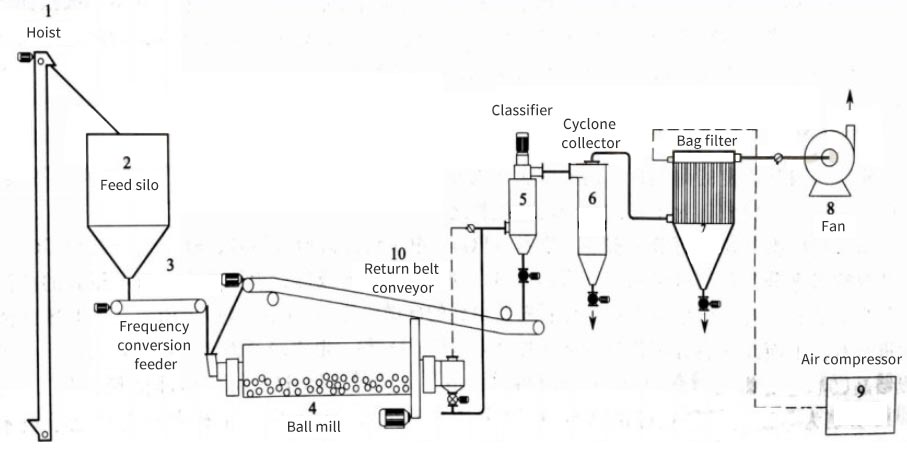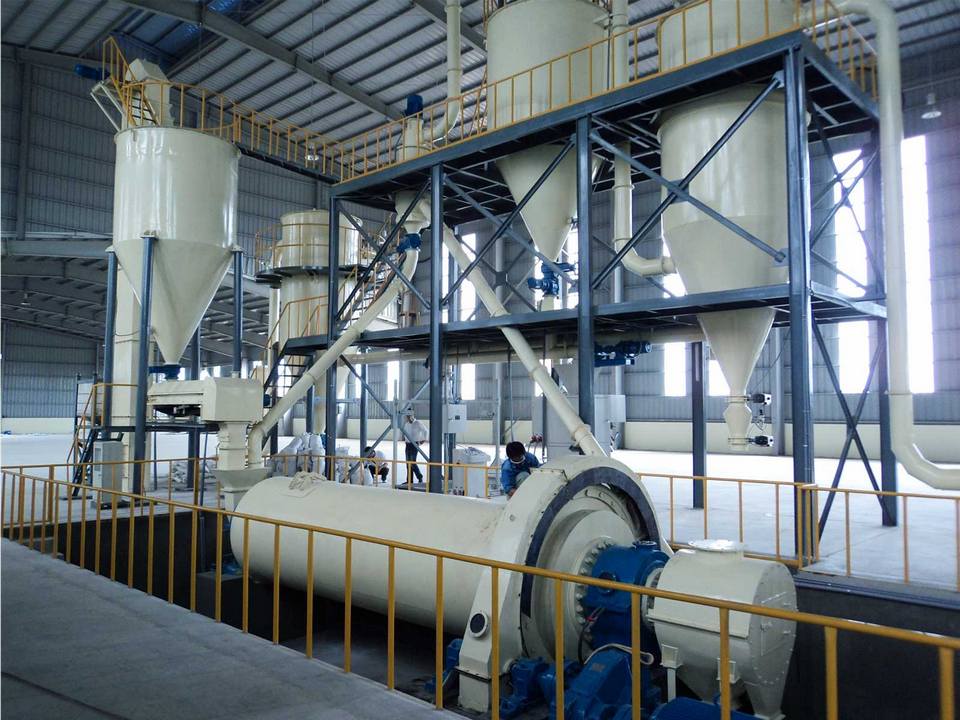Application, processing technology and development trend of silicon powder
Silicon micropowder is made of natural quartz (SiO2) or fused quartz (amorphous SiO2 after high temperature melting and cooling of natural quartz) after crushing, ball milling (or vibration, jet milling), flotation, pickling purification, high-purity water treatment, etc. The micro powder processed by this technology.
Silicon micropowder is a non-metallic material that is odorless, non-toxic and non-polluting. It has the advantages of high hardness, low thermal conductivity, high temperature resistance, insulation and stable chemical properties.
According to the level of silicon powder, it can be divided into: ordinary silicon powder, electrical grade silicon powder, fused silicon powder, ultrafine silicon powder, spherical silicon powder. According to the purpose, it can be divided into: fine silicon powder for paint and coating, fine silicon powder for epoxy floor, fine silicon powder for rubber, fine silicon powder for sealant, fine silicon powder for electronic and electrical grade plastics, and fine silicon powder for precision ceramics. According to the production process, it can be divided into: crystalline powder, cristobalite powder, fused powder, and various active powders.
Application of silicon powder
According to its different quality grades, microsilica powder can be used in the production fields of rubber, plastics, advanced paints, coatings, refractory materials, electrical insulation, electronic packaging, high-grade ceramics, precision casting, etc.
Ordinary silicon powder is mainly used for epoxy resin casting paint, potting material, welding rod protective layer, metal casting, ceramics, silicone rubber, ordinary paint, coating and other chemical industry fillers. Electrical grade silicon powder is mainly used for insulation casting of ordinary electrical appliances and components, insulation casting of high-voltage electrical appliances, APG (automatic epoxy resin pressure gel molding technology) process injection material, epoxy potting and high-end ceramic glaze industries.
Electrical and electronic grade silicon powder particle size distribution requirements
| Specification/Mesh | Median particle size D50/μm | Specific surface area/(cm2/g) | Cumulative granularity |
| 300 | 21.00~25.00 | 1700~2100 | ≤50μm≥75% |
| 400 | 16.00~20.00 | 2100~2400 | ≤39μm≥75% |
| 600 | 11.00~15.00 | 2400~3000 | ≤25μm≥75% |
| 1000 | 8.00~10.00 | 3000~4000 | ≤10μm≥65% |
Electronic grade silicon micropowder is mainly used for integrated circuits and electronic components plastic packaging materials and packaging materials, epoxy resin casting materials, potting materials and high-grade paints, coatings, engineering plastics fillers, adhesives, silicone rubber, precision casting , High-grade ceramic glaze fillers and other chemical fields. The annual consumption of epoxy molding compound is tens of thousands of tons, and the content of silica powder in the filler accounts for 70% to 90%.
The SiO2 content of high-purity ultra-fine silicon powder is higher than 99.9%, and it has the characteristics of small particle size, large specific surface area, high chemical purity, and good filling ability. Mainly used for large-scale and ultra-large-scale integrated circuit plastic molding compound, electronic component molding compound, epoxy castable potting compound, high-grade coatings, paints, engineering plastics, adhesives, silicone rubber, precision casting, advanced ceramics and chemicals field.
Spherical silicon powder has a high filling rate, and the smaller the expansion coefficient, the lower the thermal conductivity; the plastic packaging compound has the least stress concentration and the highest strength; the friction coefficient is small, and the wear on the mold is small. Mainly used in electronic plastic packaging materials, coatings, epoxy floors, silicone rubber and other fields.
In order to better fuse non-metallic mineral fillers with high molecular polymers, non-metallic minerals must be crushed, purified and modified. Generally speaking, the smaller the particle size of the filler and the more uniform the dispersion, the better the mechanical properties of the product.
Superfine grinding of silicon powder
The use of natural quartz minerals as raw materials to prepare ultrafine powder is not only to meet market demand, but also to better reduce the content of harmful impurities in the powder. Natural quartz mineral contains a large number of inclusions and cracks. The use of ultra-fine crushing technology can greatly reduce the number of cracks and defects. Combined with the purification process, the content of harmful impurities can be better reduced. The preparation of crystalline powder, cristobalite powder, fusion powder and various active powders requires a grinding and classification process.
The choice of ultra-fine grinding and ultra-fine equipment will directly affect the output, quality and shape of the powder particles of the final product. At present, the unit combinations of ultra-fine grinding and ultra-fine grinding equipment include: ball mill plus grading, eccentric vibration mill plus grading, and vibration mill plus grading.

The characteristics of the ball mill classification production line: large output, simple equipment operation, low maintenance costs, flexible selection of grinding media and liners, low pollution to the high-purity processing of materials, reliable overall operation of the equipment, and stable product quality. The application of silicon powder can make the product high in whiteness, good gloss and stable quality index. The production of high-purity ultra-fine silicon powder is obtained by further ultra-fine pulverization or grinding and classification on the basis of the preparation of high-purity sand.

Surface modification of silicon powder
The effect of silane coupling agent applied to the surface modification of silicon powder is very ideal. It can transform the hydrophilicity of silica powder into an organic-philic surface, and can also improve the wettability of organic polymer materials to its powder, and make the silica powder and organic polymer materials realize a strong covalent bond interface through functional groups. .
The application effect of silane coupling agent is related to the selected type, dosage, hydrolysis condition, substrate characteristics, application occasions, methods and conditions of organic polymer materials.
Sphericalization of silica powder
At present, 97% of integrated circuit (IC) packaging materials use epoxy molding compound (EMC), and in the composition of EMC, silicon micropowder is the most used, accounting for 70% to 90% of the mass of epoxy molding compound. Compared with the angular silicon micropowder, the annular silicon micropowder has a higher filling rate, a smaller thermal expansion coefficient, lower thermal conductivity, less stress concentration, higher strength, and better performance of the microelectronic devices produced. Therefore, In addition to high-purity and ultra-fine particles, particle spheroidization has also become one of the development trends of silicon micropowders.
The current methods for preparing spherical silicon powder can be divided into physical methods and chemical methods. The physical methods are: flame balling method, high temperature melting spray method, self-propagating low temperature combustion method, plasma method and high temperature calcining spheroidization. Chemical methods include: gas phase method, hydrothermal synthesis method, sol-gel method, precipitation method, microemulsion method, etc. In chemical methods, due to the serious agglomeration of particles, the larger specific surface area of the product, and the large oil absorption value, it is difficult to mix with epoxy resin when a large amount is filled. Therefore, the current industry mainly adopts physical methods.
Overview of the development of silicon powder industry
The silicon powder industry is a capital, technology, and resource-intensive industry. With the development of high-tech industries, silicon micro-powders have become more widely used and used more and more. The world’s demand for high-purity ultra-pure silicon powder will develop rapidly with the development of the IC industry. It is estimated that the world’s demand for it will increase at a rate of 20% in the next 10 years. Ultra-fine, high-purity silicon powder has become a hot spot for the development of the industry, spherical silicon powder has become the development direction of the industry, and surface modification technology has been intensified.
Article source: China Powder Network
